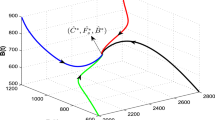Abstract
Global warming is a major problem of twenty-first century requiring effective measures to control it. The present study deals with the abatement of carbon dioxide (an important global warming gas) from the atmosphere using greenbelt plantation and seaweed cultivation. The carbon dioxide emission into the atmosphere is assumed to be dependent on natural as well as human population density-related factors. In modeling process, four nonlinearly interacting variables, namely the concentration of carbon dioxide in the atmosphere, the density of human population, the biomass density of greenbelt plantation and the biomass density of seaweeds, are considered. The proposed model is analyzed using stability theory of differential equations. The model analysis shows that if the densities of biomass in greenbelt plantation and seaweed cultivation increase the concentration of carbon dioxide from the atmosphere decreases considerably. The human population-related activities are, however, found to increase the concentration of carbon dioxide in the atmosphere.










Similar content being viewed by others
References
Arman H (2015) Uncertainties, risks and challenges relating to emissions and its possible impact on climate change in the United Arab Emirates. Int J Global Warm 6(5):1–17
Cazenave A (2006) How fast are the ice sheets melting?. Science 314:1251–1252
Douglas HE, Selden TM (1995) Stoking the fires? emissions and economic growth. J Pub Econ 57(1):85–101
Duarte CM, Middelburg J, Caraco N (2005) Major role of marine vegetation on the oceanic carbon cycle. Biogeosciences 2:1–8
Gregory JM, Oerlemans J (1998) Stimulated future see level rise due to glacier melt based on regionally and seasonally resolved temperature changes. Nature 391:474–476
Harley CDG, Hughes AAR, Hultgrem KM, Miner BG, Sote CJB, Thornber CS et al (2006) The impacts of climate change in coastal marine systems. Ecol Lett 9:228–241
Hoegh-Guldberg O, Mumby PJ, Hooten AJ, Steneck RS, Greenfield P, Gomez E et al (2007) Coral reefs under rapid climate change and ocean acidification. Science 318:1737–1742
Hopkins WG, Norman PAH (2009) Introduction to plant physiology, 4th edn. Wiley, New York
Israel A, Hophy M (2002) Growth, photosynthetic properties and Rubisco activities and amounts of marine macroalgae grown under current and elevated seawater concentrations. Glob Change Biol 8:831–840
Khasnis AA, Nettleman MD (2005) Global warming and infectious disease. Arch Med Res 36(6):689–696
Kumar M, Yasmeen T, Nautiyal DC, Pandit MK (2016) Modelling the impacts of future climate change on plant communities in the Himalaya: a case study from Eastern Himalaya, India. Model Earth Syst Environ 2:1–12
Kurane I (2010) The effect of global warming on infectious diseases. Osong Public Health Res Perspect 1:4–9
Misra AK, Verma M (2013) A mathematical model to study the dynamics of carbon dioxide gas in the atmosphere. Appl Math Comput 219:8595–8609
Mongin M, Baird ME, Hadley S, Lenton A (2016) Optimising reef-scale removal by seaweed to buffer ocean, acidification. Environ Res Lett 11:034023
Naresh R, Sundar S, Shukla JB (2007) Modelling the removal of gaseous pollutants and particulate matters from the atmosphere of a city. Nonlinear Anal Real World Appl 8(1):337–344
Pelejero C, Calvo EVA, Hoegh-Guldberg O (2010) Paleo-perspectives on ocean acidification. Trends Ecol Evol 25:332–344
Rautela P, Karki B (2015) Impact of climate change on life and livelihood of indigenous people of higher himalaya in Uttarakhand, India. Am J Environ Prot 3(4):112–124
Raven JA (2005) Ocean acidification due to increasing atmospheric carbon dioxide. The Royal Society London
Robinson BA, Robinson NE, Willie S (2007) Environmental effects of increased atmospheric carbon dioxide. J Am Phys Surg 12:79–90
Shukla JB, Misra AK, Sundar S, Naresh R (2008) Effect of rain on removal of a gaseous pollutant and two different particulate matters from the atmosphere of a city. Math Comp Model 8(5–6):832–844
Shukla JB, Chauhan MS, Sundar S, Naresh R (2015) Removal of carbon dioxide from the atmosphere to reduce global warming: a modeling study. Int J Global Warm 7(2):270–292
Sundar S, Naresh R (2017) Modeling the effect of dust pollutants on plant biomass and their abatement from the near earth atmosphere. Model Earth Syst Environ 3(1):42
Sundar S, Mishra AK, Naresh R (2018) Modeling the impact of media awareness programs on mitigation of carbon dioxide emitted from automobiles. Model Earth Syst Environ 4(1):349–357
Wu SH, Zhang WJ (2012) Current status, crisis and conservation of coral reef ecosystems in China. Proc Int Acad Ecol Environ Sci 2(1):1–11
Wu HY, Zou D, Gao K (2008) Impacts of increased atmospheric CO2 concentration on photosynthesis and growth of micro- and macro-algae. Sci China Ser C Life Sci 51(12):1144–1150
Wu SH, Pan T, He SF (2012) Climate change risk research: a case study on flood disaster risk in China. Adv Clim Change Res 3(2):92–98
Zhang H, Wang Z (2011) Advances in the study of black carbon effects on climate. Adv Clim Change Res 2(1):23–30
Author information
Authors and Affiliations
Corresponding author
Additional information
Publisher’s Note
Springer Nature remains neutral with regard to jurisdictional claims in published maps and institutional affiliations.
Rights and permissions
About this article
Cite this article
Sundar, S., Mishra, A.K., Naresh, R. et al. Modeling the impact of population density on carbon dioxide emission and its control: effects of greenbelt plantation and seaweed cultivation. Model. Earth Syst. Environ. 5, 833–841 (2019). https://doi.org/10.1007/s40808-019-00570-6
Received:
Accepted:
Published:
Issue Date:
DOI: https://doi.org/10.1007/s40808-019-00570-6




